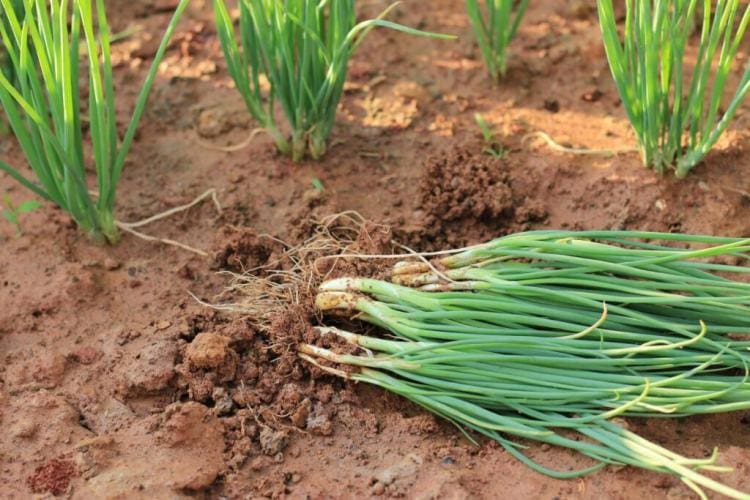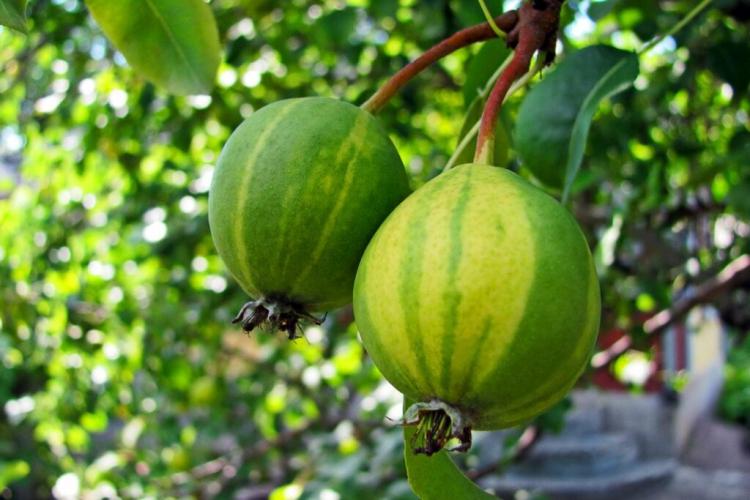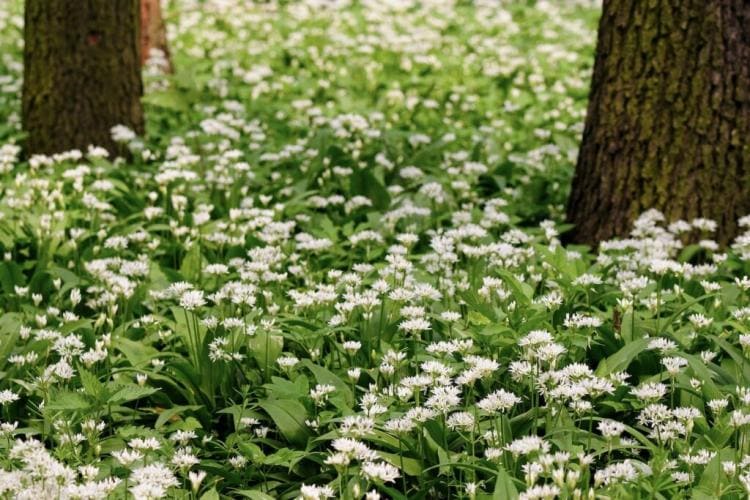Spring Onion: Everything About the Healthy Mini Onion
Spring onions are one of the healthiest vegetables and can be used in many ways in the kitchen. We give tips on cultivation, harvesting and storage.

Spring onions are very popular in the kitchen because of their delicate aroma [Photo: Afanasieva / Shutterstock.com]
A vegetable that is known almost all over the world is the onion. And rightly so! Because onions are not only delicious and give every hearty dish the finishing touch, they are also very healthy. The spring onion (Syn .: spring onion, winter hedge, Allium fistulosum ) is an onion shape with a particularly fine onion aroma. This onion shape, which is particularly widespread in Asia, belongs to the large leek family ( Allium ). The onion herb is said to have its origin in the Orient. The hardy spring onions began their arrival in Europe from Russia. But there are also reports that the onion was cultivated in China 2,000 years before our era. The appearance of the spring onions also differs depending on the region. In Asia, a shape is usually grown that is more reminiscent of chives and has a very fine taste. We prefer stronger spring onions, which are now also available in red (varieties: Red Toga and Red from Florence) or other colors.
Differences between spring onions, spring onions & Co.
Table of Contents
Since there are many misleading names for the leek and onion plants, it is sometimes not entirely clear which name is correct for which vegetable. The most important representatives of the Allium family (in addition to the spring onion) include the kitchen onion ( Allium cepa ), chives ( Allium schoenoprasum ), garlic ( Allium sativum ), leeks ( Allium ampeloprasum ) and wild garlic ( Allium ursinum ). Sometimes you get to hear that the spring onion is just an early-harvested kitchen onion – but that’s not true. Because the spring onion, also called winter onion by experts, is not able to form a thick onion. The typical cylindrical slight thickening remains. Nevertheless, the leaves of the normal kitchen onion are edible and can be used just as well in the kitchen. The real leek is a closely related plant of the spring onion, but there is a clear difference here as well: The real leek has flattened leaves and not tubular leaves, as the onion and the spring onion do. The name spring onion is just a synonym for spring onion, so it is the same plant.
You can find more information about differentiating bulbous plants here.

Spring onions are easy to grow and taste great [Photo: igorstevanovic / Shutterstock.com]
Spring onions: sowing and growing in your own garden
Spring onions should not be missing in any garden, because cultivation is not particularly difficult and fresh spring onions from your own garden simply taste best. You can also harvest large quantities from the same plant over several years.
Propagate spring onions
Usually, spring onions are propagated from seeds. Because of its extreme winter hardiness, the spring onion can be sown early in spring. Germination then takes a little longer (up to 14 days), but you can enjoy the first vegetables early in the season. For an even earlier harvest, the spring onions can also be sown in autumn. The small spring onions have no problem with frost and snow. After winter, the bulb plants can start growing straight away and thus reach harvest size more quickly. For sowing, the fine seeds are simply scattered in lines and lightly (0.5 cm) covered with soil. Keep in mind that the spring onions should later be 2 cm apart in the row and 2.5 cm between the rows. So it is better to sow a few more seeds and if the plants are a bit larger, the seedlings are separated at the appropriate distance.

Spring onions are happy about a place in full sun [Photo: greenaperture / Shutterstock.com]
In addition to propagation via seeds, vegetative propagation is also possible. Spring onions form a clump that can be easily divided. A eyrie is a collection of many plant shoots, each of which can become an independent plant. After the division, the clumps are simply buried again and growth is not long in coming. A clump should have no fewer than three shoots so that it can safely grow again.

Spring onion clumps can be split [Photo: Vanatchanan / Shutterstock.com]
The perfect location for spring onions
Spring onions love light and sandy soil. Heavy soil quickly leads to waterlogging and they don’t like onions at all. In addition, heavy soil contains many nutrients. However, spring onions are poor eaters and a high supply of nutrients leads to a bland taste. In contrast, the spring onion needs full sun. The sunnier the location, the more intense the onion aroma will be. When temperatures between 15 and 20 ° C still prevail, the onion has optimal growth conditions.

Spring onions are poor eaters [Photo: karpovkottt / Shutterstock.com]
Of course, the spring onion can also be grown in a raised bed or in a pot. However, the spring onion in the pot does not offer particularly attractive ornamental value and the space in the raised bed should be reserved for plants that require more care. A bed that is as weed-free as possible is sufficient for the spring onion. The spring onion is also suitable as a mixed culture. Since it grows slowly at first and is not particularly large, it does not shade other cultures or only imperceptibly. Other small plants such as spinach or radishes can therefore thrive next to the bulbous plant.
Water and fertilize spring onions
When it comes to the water supply, the spring onion is not particularly demanding. Additional watering should only be used in longer and warm weather without rain. In any case, avoid waterlogging.
You should also hold back when it comes to the supply of nutrients. Avoid fresh compost, as it favors the onion fly infestation. When sowing in autumn, nitrogen should also generally be avoided. Fertilize only lightly with potassium and phosphate. In spring, you can then fertilize with a little nitrogen. It can also be useful to divide the fertilizer application into many small applications. Because nutrients such as nitrate are washed out particularly quickly from light, sandy soil.
You can find even more tips for growing spring onions in your own garden here.
Spring onion varieties: New, tried and tested and robust
The selection of varieties of spring onions is relatively large, but the differences between most varieties are not particularly clear. Varieties such as Freddy, Tonda Musona, Pal, Ishikura, Negaro or Totem (F1) are spring onion varieties with white shaft and green leaves, whereby the Freddy variety is the most common and also the best known. At this point we would also like to introduce you to the Da Mazzi Bunching variety. In this variety only small leaves are formed, most of the energy goes into the formation of the stem. Since the white shaft is very mild, Da Mazzi Bunching is particularly suitable for friends of the mild onion taste. One variety that deserves special mention as well is the Feast variety. It is very heat-tolerant and is therefore particularly suitable for summer cultivation or for hobby gardeners with a poor water supply.
Take a look at our spring onion variety overview!
But there are also two varieties with an unusual color. The varieties Red Toga and Rote von Florenz have (as the name suggests) a red shaft. Not only does it look good, it also makes the onions particularly healthy. Because the red dye (anthocyanins) traps free radicals in our body.

Spring onions are not only available in white [Photo: Creative Family / Shutterstock.com]
There are also spring onions on offer, which are simply referred to as “leek” or “white spring onion”. In our opinion, such offers are just as suitable for successful spring onion cultivation as spring onions with well-known variety names. Often “spring onions” are also offered, which are supposed to form a real onion. In most cases, this is the normal kitchen onion. The De Vaugirard variety is one of these false spring onions. You should therefore always be skeptical about alleged spring onions that form a real onion. If the Latin name Allium cepa is on the packaging, then it is the normal kitchen onion and not the real spring onion Allium fistulosum .
Harvesting, storing and preserving spring onions
In warm weather conditions and in a good location, the harvest takes place three months after sowing. At this point, the leaves should be about 10 inches tall. Since the spring onion does not have a fixed time of sowing, there is also no fixed time of harvest in the season. When harvesting it is up to you whether you want to harvest the whole plant or just the vents (green leaves). When the whole plant is harvested, the bed is free for a new crop and the whole plants can be stored for longer. If only the leaves are cut off, harvesting is possible all year round. The spring onion can even withstand permanent cultivation over several years, because the leaves keep growing back.

Spring onions taste best when they are freshly picked [Photo: Pinkyone / Shutterstock.com]
However, cut leaves are only really fresh for a day or two in the refrigerator. The whole spring onion, on the other hand, can be kept in the refrigerator for 1 to 2 weeks. Some people also swear by putting the harvested spring onions in a water glass. This should make them particularly durable. In any case, the green onions will lose their aroma from day to day. That is why you should always harvest fresh. In our opinion, this is exactly where the greatest advantage of home-grown spring onions lies: They can be harvested fresh from the bed.
Tip : If the harvest is too abundant, it is best to freeze the spring onions. Wash it thoroughly and put it in the freezer.
You can find out more about harvesting and storing spring onions here.
Diseases and pests of spring onions
The spring onion already has many resistances. However, with persistent moisture, downy mildew can occasionally occur. In some regions, onion leafminer flies and other vegetable flies also cause greater damage, but only a very fine-meshed culture protection net can help. As a rule, however, spring onions are spared from pests, so that no special plant protection measures are necessary. However, crop rotation should be adhered to when growing onions. This means that onion plants should only be grown on the same bed every 4 years.
Spring Onions: Ingredients and Uses in Cooking
Spring onions are (like all onions) very low in calories. This is due, among other things, to a certain form of sugar that the spring onion makes. The fructan stored in onions is indigestible for humans. However, our intestinal flora is very happy about this starch substitute. Another special ingredient are the characteristic sulfur compounds. They not only provide the unmistakable onion taste and tears in the eyes, but are also strongly antibacterial and should prevent cancer. The onion also contains many minerals and vitamin C.

When cut into small pieces, the spring onion unfolds its wonderful aroma [Photo: glebchik / Shutterstock.com]
The spring onion can be used in the kitchen wherever the kitchen onion is used. The white part of the spring onion is not very tasty in contrast to the green leaves. The raw green leaves can develop their full aroma in salads in particular. For warm dishes, you should add the green leaves just before serving, otherwise the consistency is very soft. The white portion, on the other hand, can be cooked longer.

Spring onions are great with soups [Photo: Barbara Neveu / Shutterstock.com]
Tip: Try the seeds as a spice. These have a great aroma, which is, however, quite volatile. Therefore, the seeds should always be kept whole.
Did you know it’s easy to grow green onions back? We’ll show you how to do this in our article on reusing vegetable scraps.






